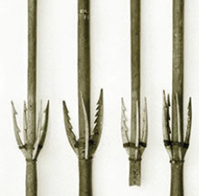Grant Keddie. 2023.
Introduction
The identification of bone projectile points found in archaeological sites that were used as components of bird spears and bird arrows are difficult to identify. This is due, in part, to the lack of Museum ethnographic examples with accurate documentation. Old traditional bird spears or arrows are rare in Museum collections. With the introduction of iron and the gun, the components of the spears and arrows changed and then they disappeared from use.
Bird spears have several components: a shaft, a central bone point with up to five other bone points of several sizes or two bone points positioned at the same level on the distal end of the spear. Most of these are barbed but some are not. Some have only a central point with two side barbed points just below or two side mounted bone points attached further down the side of the shaft. The shaft is made of light wood that can float and is usually more than 1.2 meters in length.
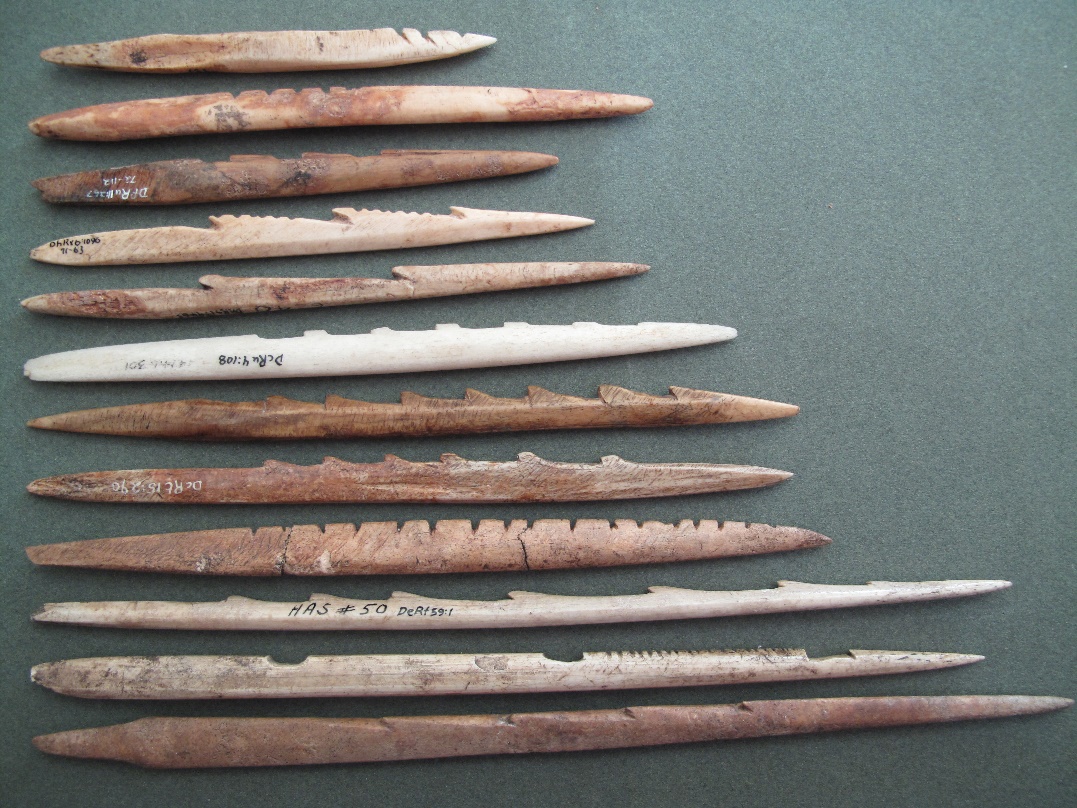
There is sometimes confusion in the literature between bird spears and bird arrows and a lack of comparison with barbed fish spear points. It is important when trying to define what are traditional bird spears, that recorded information is coming from either Indigenous elders that made or remember seeing these weapons in the 1800s when they were young, or non-indigenous eye witnesses who observed and wrote about them being used in the early to mid 1800s.
I will present rare examples here from museum and private collections, with an overview of those presented in the ethnographic literature, This article should be considered as a starting point for more detailed metric studies that need to be done in the future. My geographical focus here is the southeastern corner of Vancouver Island and the northeastern Olympic Peninsula and Puget Sound.
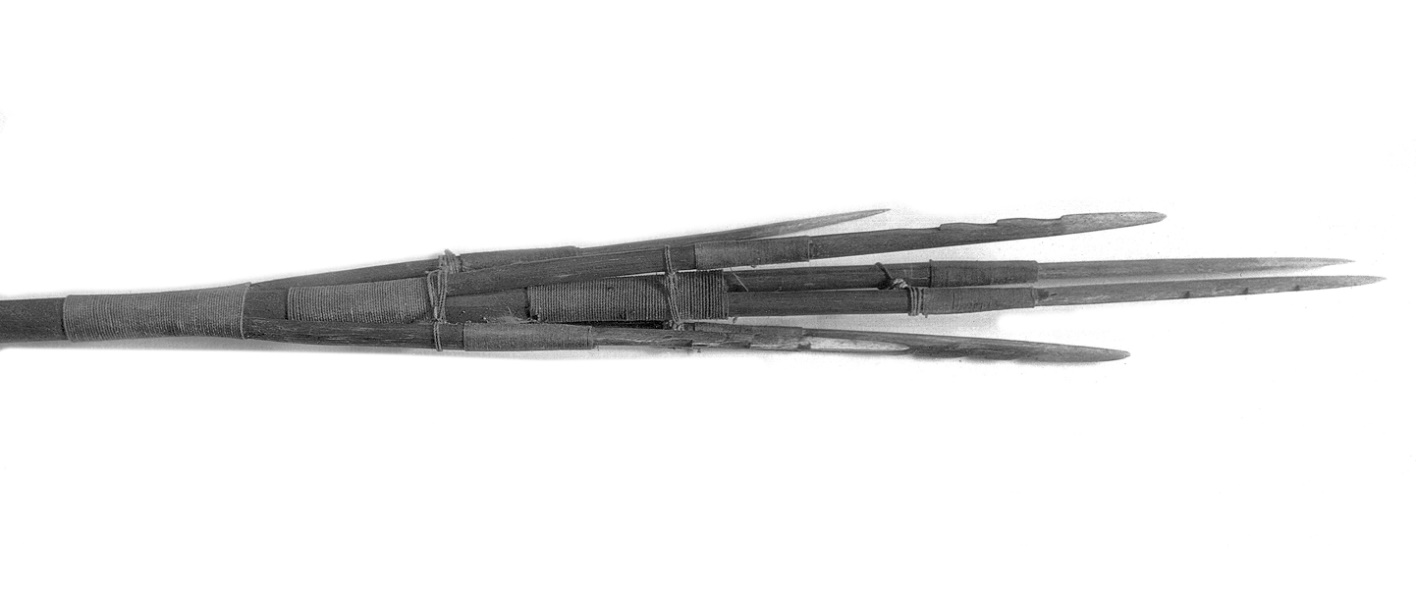
The Ethnohistoric Record
Anthropologist Bernhard Stern, in 1928-29, acquired information from older Lummi people born in the time period around 1848 to 1858. Local cultures were being extensively influenced by this time, especially with the introduction of the gun, but some traditional hunting practices continued in isolated communities.
The Lummi spoke the same north straits language as the Lekwungen people of the Victoria region. Stern observed that the duck spear, called a “teskeman”, has: “five sharp prongs made by tying five notched and pointed pieces of ironwood, yew-wood or bone, with wild cherry bark to an eight-or-ten-foot pole. The top prong is about 14 inches [35.5cm], the two next about ten inches [25cm] and the remaining two about eight inches [20.3cm] long. The notches prevent the ducks from slipping off easily when they are speared. The spear is used on dark calm nights by a man sitting in the bow of a canoe paddled by another who sits in the stern and occasionally kills duck by striking them with his paddle. A pitch-wood fire is built on a platform about three feet square, set in the stern of the canoe, covered with sand to prevent the fire from burning too rapidly. The fire attracts the ducks and dazzles them as they come toward the canoe” (Stern 1934).
The bid spear described by Stern appears to be like that shown in figure 2. Homer Barrnett shows a “Five-pronged spear used in night duck hunting” on the southern coast (Barrnett 1955). The latter has a central point that is not barbed and has a pair of barbed points extending out and higher on both sides.

Anthropologist Wayne Suttles noted: “The duck spear evidently differed from group to group or perhaps from hunter to hunter. The Samish duck spear consisted of a cedar shaft of unstated length with a trident butt, a fir fore shaft, and 4 barbed points fixed radially. The points were of deer bone or perhaps whale bone. Two where above 6 inches and two shorter; each had three barbs on one side”.
Saanich consultants indicated to anthropologist Diamond Jenness that men went out hunting ducks in a canoe with a “small fire in an earth filled box” and “speared or clubbed them when they driffed within reach … A Duncan native said that his people used a spear with two points, which seems to be the usual type, but a Tsawout man of East Saanich stated that the spears of his family group had four points, three blackened, the fourth painted for aiming” (Jenness 1934).
Swans were stocked from shore and shot with bow and arrow (Suttles 1951). This was a common practice around the Pacific Rim with the larger birds. The arrows tended to have a single barbed bone point (figure 7).
Thomas Waterman, a field collector for the Museum of the American Indian from 1919-1922, documented information about bird spears in the Puget Sound area in a 1921 manuscript:
“My informants describe a three-pronged spear used for hunting birds though I never succeeded in obtaining a specimen. The Ferry Museum at Tacoma has one specimen on exhibition, but where it was obtained, they could not tell me” (Waterman 1973).
Myron Elles, of Washington State, describes the bird spear as follows:
“The Duck Spear. Usually, the handle is 15 or 20 feet long [457.2-609.6cm], and it has three or four prongs, with notches in them, fastened to the handle at one end. They are notched. They branch so far apart as not to injure the body of the duck, being intended simply to catch in the feathers. Generally, the prongs are made of hard wood, but occasionally of bone. I obtained one of bone for the Columbia Exposition. One of bone which I have was found near Port Townsend and one which is owned by J.Y. Collins of Whatcom was found on the Lummi reservation. It is 10 ½ inches[26.5cm] long, and ¼ inch [0.6cm] thick. Iron is now often substituted both for bone and wood. … Many years ago, at times I have seen many lights on the water, of those thus catching ducks and fish when it is dark, and the scene is quite beautiful. Sometimes, especially in foggy weather, the Indians cover their canoes with green boughs, among which they hide and then paddle quietly among the ducks, and shoot them. The silly birds imagine that it is a tree floating toward them” (Elles 1985).
Myron Elles suggests that a person could either throw or jab a spear from a boat. He indicates the six points are “flat with series of barbs on outer edge” and the spear has a pair of fore shafts with: ”Four additional fore shafts, somewhat shorter than the first pair, are attached in pairs …The two original points project several inches farther forward than the others”.
Figure 4, shows a drawing with five multi-barbed points that Elles did of the Port Townsend “duck spear”. This was illustrated in Ruby and Brown (1976).

Elles describes bird arrows:
“The shaft of the common arrow was either of cedar or ironwood. The head was of ironwood or bone, and often 6 or 7 inches [15-18cm] long. Lately they have made them of wire, about 1/16 of an inch [0.3cm] in diameter, and five or six inches [12.5-15.2cm] long. Sometimes those with a single head had a serrated edge to catch in the feathers of the bird. Others were made for birds, with double or forked-heads, some of whose edges were serrated and some of which were not” (Elles 1985).
Figure 5, shows three types of Klallam bird arrows from the northern Olympic Peninsula of Washington Sate. The barbs of the bone points are facing outward as opposed to being on the inside with two-pronged fish spears.
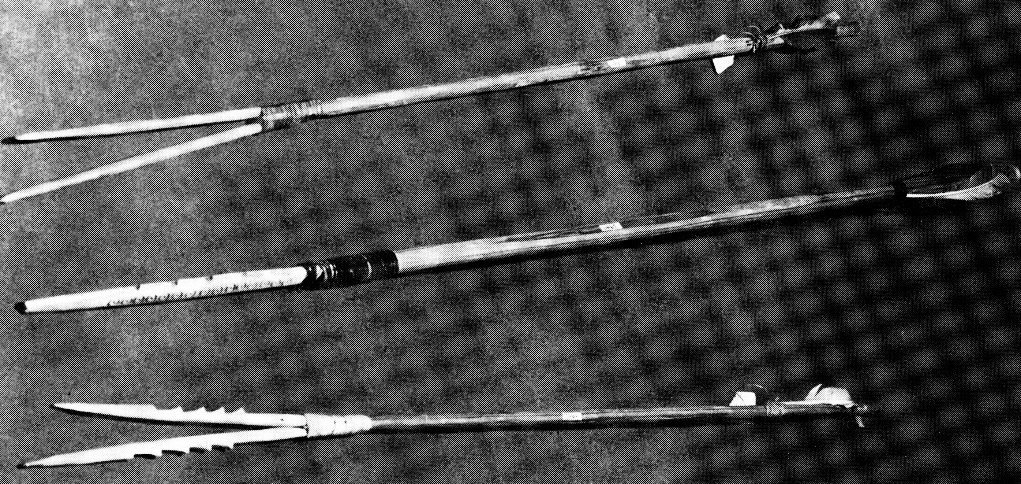
Waterman indicates there are six barbs on a bird spear: “not two as on fish spear”. (Waterman 1973). Ruby and Brown show a “two-pronged serrated duck arrow” showing the barbs on the points facing outward (1976).
James Wood illustrates two arrows (Figure 6) from his own collection that would date before 1878. Although he writes about the West Coast of Vancouver Island, he does not indicate where the arrows come from. He provides a good description of why the barbs are turned inward and how the end has a grasping function:
“The arrows are of various kinds according to the object which they are intended. That which is used for ordinary occasions is shown in the uppermost figure of the illustration. It is two feet three inches [70.4cm] in length, and is headed with bone. …The lower figure represents the arrow that is used for killing fish. In this weapon the point is also of bone, but is very much longer, and is double, the two halves being barbed on the inner surface. It is firmly lashed to the shaft, and their divergence is given by means of two pegs, which are driven between the haft and he two potions of the point. If a fish be stuck by this ingenious weapon, it cannot possibly escape, the elastic points contracting violently and holding the fish between them” (Wood 1878).

Boas has a diagram of a six barbed “bird spear” from the Northeastern Vancouver Island region. He comments: “Sometimes birds are hunted with a many pointed spear, which is attached to a handle similar to the harpoon shaft. It seems that this device is used particularly by the Nootka, but it seems that it has also been adopted to a certain extent by the Kwakiutl” (Boas 1909).
The type of multi-pronged bird spear, like those further south, is not found on the west coast of Vancouver Island. Anthropologist Philip Drucker observed: “The multipronged bird spears attributed to the Nootkans [Nuu-chan-nulth] on the basis of the [Captain] Vancouver collections were denied by all informants. Possibly the specimens in question were collected in the Gulf of Georgia rather than at Nootka Sound (Drucker 1951).

The Anacortes Museum Spear
The best example of a duck spear is one from the collection of Charles LeRoy Judd of Anacortes Washington that was donated to the Anacortes Museum in Washington State (Figure 2 & 7). A photograph of this (RBCM PN9790) was taken by William A. Newcombe with other objects in Judd’s collection. An enhanced view of this small image is seen in figure 7. I observed this specimen in the Anacortes Museum in the 1990s. The specific place where this spear came from was not given, but a 1925 newspaper article explains that: ”Most of his collection consists of implements of the civilization of the Pacific coast Indians, especially of the Samish Indians, who lived on Fidalgo island” (Anacortes 1925).
The Anacortes bird spear has six bone points with four wooden prongs and several fore shafts. The two highest un-barbed points are fixed in a fore shaft which fits into a shorter fore shaft. There are two barbed points on lower down fore-shafts that protrude out to the sides and two smaller non-barbed points lower down.
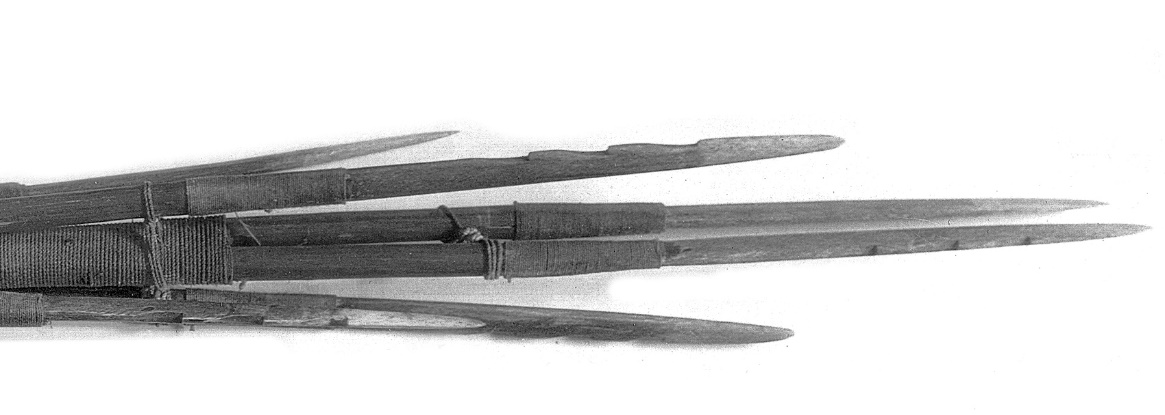
Royal B.C. Museum Bird Spears
RBCM Bird Spear. RBCM 4135 a-e.
This was a complete spear until portions had become disassembled before 1946. At this time there was no trained ethnologist or conservationist at the (then) Provincial Museum, to take care of the collection. It was “Lost in 1936 while on loan in Vancouver” and “ Found again 1946-A.E.P”. The latter initials refer to Arthur E. Pickford who was an “assistant in anthropology” during the 2nd World War years. In 1972, an un-numbered “stick” was found in the collections and cataloged as RBCM #13674. In 1973, it was discovered that this “stick” was the shaft of spear #4135, which had been missing. The RBCM use of the #13674 has been deleted from catalogue. The shaft, now RBCM #4135e, is 228.5cm (7’ 6”) long.
This spear was part of the Dr. Simon Fraser Tolmie collection. Tolmie (1812-1886) and his son William collected a number of artifacts over a long period of time from when he was stationed at Fort Nisqually in Puget Sound from 1843-1855, and after his move to Victoria. A list of this collection was with a Tolmie letter of January 13, 1927, to William Newcombe. It was listed as #73: “Spear – 4 pronged – cedar shaft-cherry bark wrapping for ducks. Salish”. The Dr. William Fraser Tolmie and his son William Tolmie collection, RBCM #4102-4188, was purchased in 1927. The annual report of the Provincial Museum for that year lists the bird spear as: “4135. Spear, fir shaft, four hardwood prongs, cherry bark wrappings, used for ducks”. A list of the collection is archived under: “Miss J. W. Tolmie” in, RBCM GR111, Box 44, File 18.
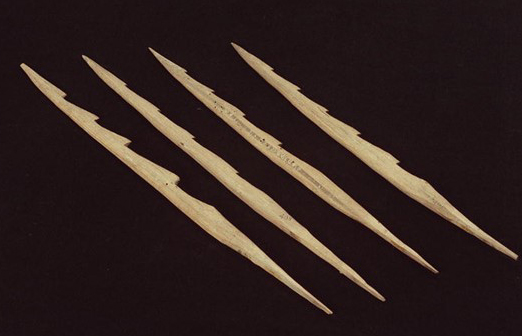
Figure 8. RBCM 4135 a-d. Four wooden barbs from a duck spear,

Figure 9. RBCM 4135-e. Shaft of a duck spear from the Tolmie Collection.
RBCM Bird Spear. RBCM 2319 a-e.
The RBCM 2319 a-e Bird spear has a total length 854mm. The shaft is 790mm long. The Width of 12mm is consistent from just before the fletching to just before the expanded area for barb attachment. Two Barbed points appear to have fallen out when it was no longer being used and were mistakenly replaced in reverse. The longest bone point is 222mm with a width of 9.3 x 6.2mm. The small bone point is 210mm long with about 12mm of the tip missing. The width is 9.3mm x 6.1mm. The material used for tying is tendon, rawhide and copper wire.
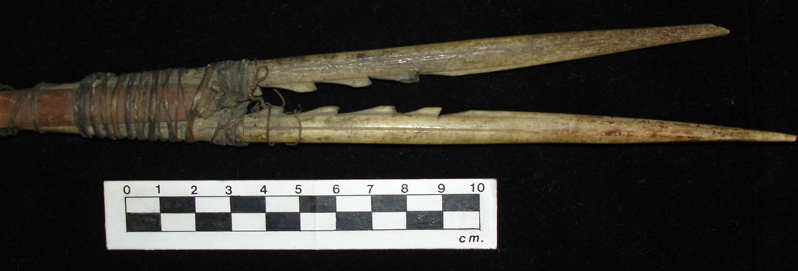
Cowichan District Bird Spear RBCM 2419 a-e.
This is the 76cm long fore-shaft portion of a longer spear. The fore-shaft is tapered at the distal end to hold four wooden prongs that are tied on with new looking wild cherry bark. Attached to the ends of the wooden prongs are four serrated edged bone points. Like most ethnological bone artifacts, the bone points are made with iron tools, but these points are not as well made as older traditional bone points. It was collected in the “Cowichan District” in 1912, by Charles Newcombe. The cherry bark ties may have been added near the time of its purchase or it was a repair job on an older spear that had come apart. Newcombe may also have commissioned the spear to be made as a model at the time. Photographed by Andrew Newman in 1978 as PN2419.

Robert Green Bird Spear. Private Collection
Bob Green of Washington State provided me with information on a bird spear (Figure 12) that had previously belonged to his father-in-law Robert Schneider. Total length 158.6cm (62 ½ inches). From the butt of the shaft to the wooden part where the points are tied is 138.7 cm (55 inches). The longest bone point is 29.2 cm (11 ½ inches). The area where the points are tied to the shaft is 9.5 cm (3 ¾ inches) in circumference. The distal end is composed of three multi-barbed barbed bone points tied into a fore shaft bound with twine.

Discussion
Bird spears and arrows from outside the region
To help identify what kinds of bone points were used on coastal British Columbia spear and arrows in the distant past we need to examine museum collections outside the area that have better documentation. Bird hunting spears are well known among the Innuit of the Aleutian Islands, as these hunting devices continued being used into the early 20th century in some regions. The characteristic Aleutian Islands bird spears had a cluster of three long barbed points at the end. It, however, was not thrown directly by hand, but was part of an atlatl device thrown with the aid of a throwing board (Van Stone 1984).
Atlatls were not known on the central Northwest Coast in historic times. They did, however, exist in the past, for a short period around 2000 years ago on some of the borders of the Salish Sea and parts of the lower Fraser River (See Keddie 1988; 2006a; 2006b)
George Quimby shows an example (Figure 14) of a Aleut bird spear which was used with a throwing board.
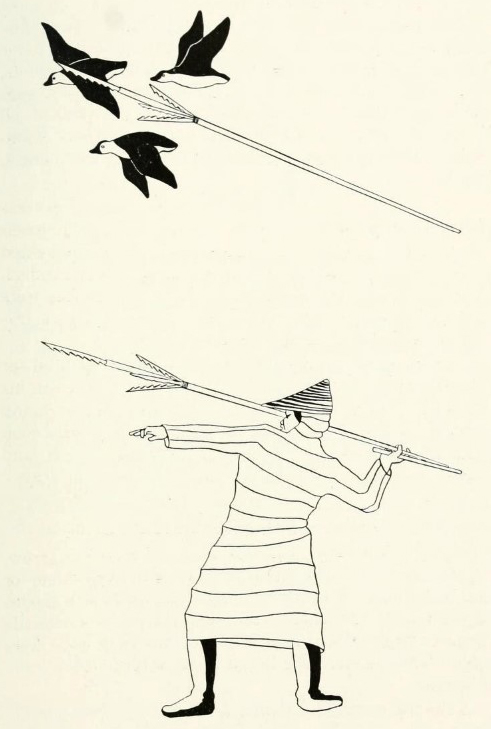
In the Aleutian Islands the larger central bone points are around 10-30cm long. Side prongs ranged from 7-27cm long and were attached 10-15cm below the point.
Aleut bird arrows were similar to Eskimo arrows. Ethnographic examples range in length from 51 to 70 cm. In the Near Islands of the Aleutians, stylistically unique cylindrical points with 1–4 unilateral barbs are a distinct characteristic of the Western Aleutians. These points are 7–9 cm long with a straight shaft and undifferentiated base with a round cross-section. Aleuts specialized in bone or ivory points and used blunt-tipped arrows to kill birds without penetrating their skins (Corbett 1916).
Figure 15, shows an Innuit boy on the Yukon Kuskokwim River Delta with Canada geese. He is holding an atlatl throwing board and bird spear with three points. The photograph was taken by O. J. Murie in July 1924.
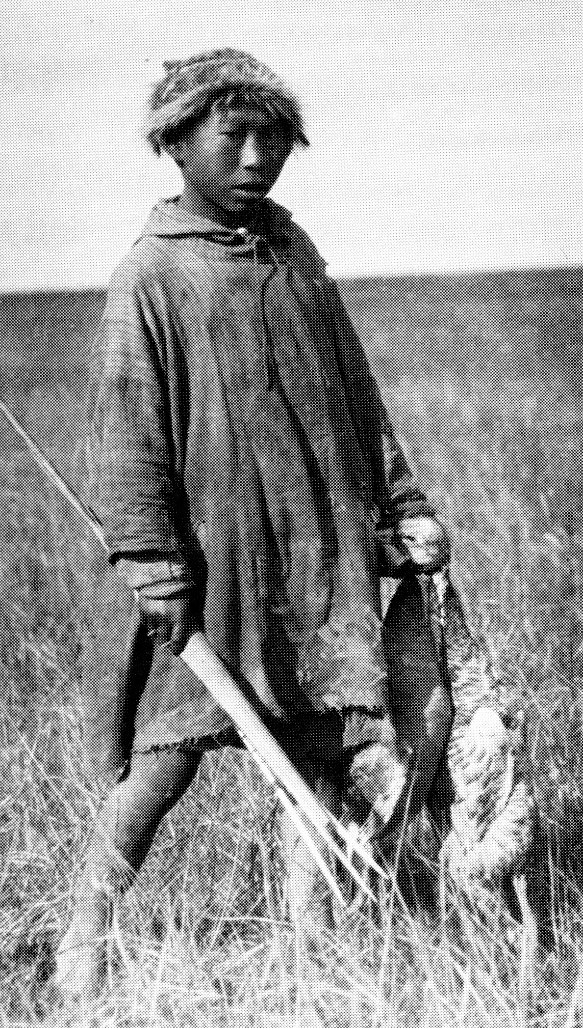
The Cook expedition of 1778 collected a bird spear from Prince Willaim Sound in Southwestern Alaska. It has a long central point with smaller barbed points below on each side like the Aleutian examples (Kaeppler 1978).
Innuit Bird Spear with Mid-shaft Barbed Points
A typical Innuit bird spear, from Victoria Island, Canada, has two barbed points on the distal end and two mid-shaft barbed bone points (Figure 16). The spear is thrown parallel to the surface of the water where a bird will be caught on the mid-shaft side barbs if it does not get caught by the distal bone points.

Figure 17, shows, on the left, examples of the mid-shaft bone points on Inuit and Aleut bird spears. They project outward in a way that would require a bone point to have an angled base. On the right are mid-shaft bone points from the spear in figure 16, that has mid-shaft bone points that are pointed and flat on the bases. These would be more difficult to identify as midshaft points.
Figure 18, shows a bone point from a Innuit spear with an angled base. Figure 19, is an antler point is from archaeological site DcRt-9, in Cadboro Bay east of Victoria. The shape of its base suggests it may have been a mid-shaft point or hafted in different way than was known in historic times.
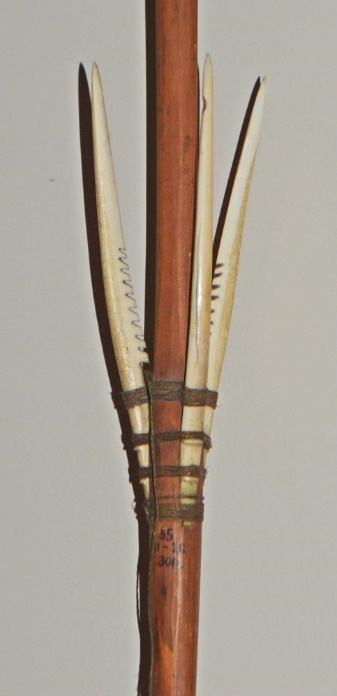

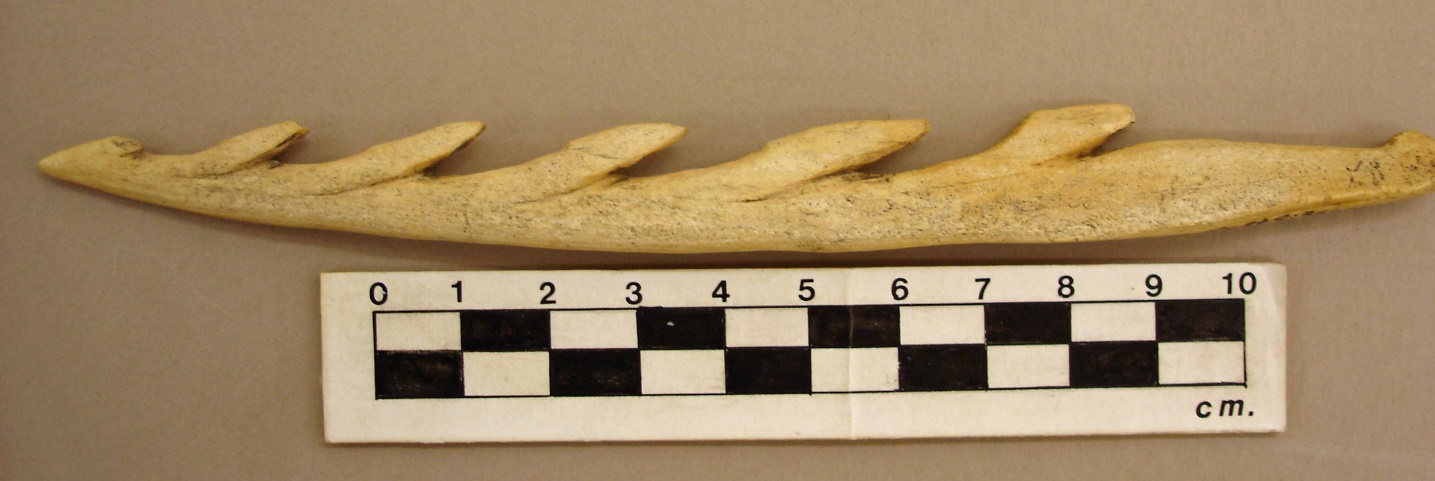
Conclusion
The bone points that are found on traditional bird spears and bird arrows come in many sizes with different attributes that serve the purpose of how they were used and how they were hafted. The rareness of well documented Museum examples and the enormous variety of bone points found in archaeological sites makes it difficult to be confident in attributing specific functions to the difference styles of bone points. In the future, the finding of intact waterlogged bird spears and arrows, DNA analysis, studying the microwear patterns on bone points and aquiring better dating sequences will contribute in part to resolving this problem of use identification.
References
Anacortes. 1925. Anacortes American newspaper, Volume 36, Number 16:2. August 27, 1925. Anacortes Man Collects Relics of Indian Passed.
Barnett, Homer. 1955. The Coast Salish of British Columbia. University of Oregon. The University Press, Oregon.
Boas, Franz. 1909. The Kwakiutl of Vancouver Island. Memoirs of the American Museum of Natural History. Publications of the Jessup North Pacific Expedition Vol II, Pt II. E.J. Brill New York.
Drucker, Philip. 1951. The Northern and Central Nootkan Tribes. Smithsonian Institution. Bureau of American Ethnology. Bulletin Number 144. Washington.
Eells, Myron. 1985. The Indians of Puget Sound. The Notebooks of Myron Elles. Edited with an introduction by George Pierre Castile. University of Washington Press, Seattle.
Jennes, Diamond. c. 1934-1935. The Saanich Indians of Vancouver Island. Field Notes. Canadian Museum of Civilization, Ms # 1103.6.
Keddie, Grant. 2006a. Atlatl Weights in the Collection of the Royal British Columbia Museum. Royal B.C. Museum Web Publication. (GrantKeddie.com).
Keddie, Grant. 1988. “The Atlatl or Throwing Board”. The Midden. Publication of the Archaeological Society of British Columbia, Vo. 20, No. 4. December 1988. (GrantKeddie.com).
Keddie, Grant. 2006b. The Quiltanton Lake Atlatl (EcRg-Y:1), A Technical Description. Royal B.C. Museum Web Publication. (Collections and Research/ Human History/Archaeology). (GrantKeddie.com).
Koepple, Adrienne L. 1978. “Artificial Curiosities” An Exposition of Native Manufacttures Collected on the Three Pacific Voyages of Captain James Cook, R.N. at the Bernice Pattahi Bishop Museum. January 18, 1978 – August 3. Bishop Museum Special Publication 65. Bishop Museum Press, Honolulu, Hawaii.
Quimby, George I. 1944. Aleutian Islanders Eskimos of the North Pacific. Department of Anthropology, Chicago Natural History Museum. Drawings by Helen Z. Quimby.
Ruby, Robert and John A. Brown. 1976. Myron Eells and the Puget Sound Indians. Superior Publishing Company, Seattle, Washington.
Stern, Bernhard J. 1934. The Lummi Indians of Northwest Washington. Columbia University Press.
Suttles, Wayne. 1974. The Economic Life of the Coast Salish of Haro and Rosario Straits. In: Coast Salish and Western Washington Indians 1, pp. 116 & 132. Garland Publishing Inc., New York.
VanStone, James. 1984. Mainland Southwest Alaska Eskimo. Handbook of North American Indians. Arctic, Vol. 5:224-246. Smithsonian Institution, Washington.
Wood, John George. 1878. The Uncivilized Races of Men in Countries of the World. Being a comprehensive Account of their Manners and Customs, and their physical, Social, Mental, Moral and Religious Characteristics. Volume II. J.A. Brainerd & Company. Cincinnati and St. louis.
Waterman, Thomas. 1973. Indian Notes and monographs. No 59. Notes on the Ethnography of the Indians of Puget Sound. Museum of the American Indian. Heye Foundation
